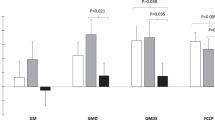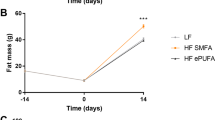Abstract
Cellular energy metabolism depends on two main energy substrates: glucose and fatty acids. The major determinants of the fuel mix oxidized are glucose availability and insulin secretion that both promote glucose oxidation. Fatty acid oxidation occurs mainly when glucose availability is reduced, for instance during the postabsorptive period, or when energy expenditure is increased, for instance during exercise of long duration. When eucaloric diets with high carbohydrate and low fat content are ingested, de novo lipogenesis is stimulated in adults, but the rate of conversion of glucose to fatty acids is low, which means that carbohydrate intake does not have much influence on fat requirements. The lower limit of fat intake depends on three factors: the fat requirement to meet energy needs, the need for essential fatty acids, and the amount of fat in the diet that is necessary to absorb fat-soluble vitamins. The lower limit of fat intake to meet the energy needs of adults is assumed to be between 10 and 15% of dietary energy, provided that enough carbohydrates are available. For adults, the requirement for essential fatty acids is in the range of 3–5% of dietary energy for linoleic acid, and 0.5–1.0% of dietary energy for linolenic acid. Fat energy should not be below 10% of total energy intake in order to ensure an unrestricted absorption of fat-soluble vitamins, particularly vitamins A and E. The recommendations on upper limits of fat intake for adults must take into account the degree of physical activity. International recommendations indicate that active individuals in energy balance may consume up to 35% of their total energy intake as dietary fat, whereas sedentary individuals should not consume more than 30% of their energy from fat. Saturated fatty acids should not exceed 10% of the energy intake.
This is a preview of subscription content, access via your institution
Access options
Subscribe to this journal
Receive 12 print issues and online access
$259.00 per year
only $21.58 per issue
Buy this article
- Purchase on Springer Link
- Instant access to full article PDF
Prices may be subject to local taxes which are calculated during checkout
Similar content being viewed by others
Author information
Authors and Affiliations
Rights and permissions
About this article
Cite this article
Jéquier, E. Response to and range of acceptable fat intake in adults. Eur J Clin Nutr 53 (Suppl 1), s84–s93 (1999). https://doi.org/10.1038/sj.ejcn.1600747
Published:
Issue Date:
DOI: https://doi.org/10.1038/sj.ejcn.1600747



